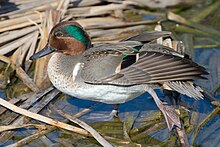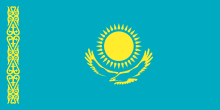Blue-green
| Blue-green | |
|---|---|
| Hex triplet | #0D98BA |
| HSV (h, s, v) | (192°, 93%, 72[1]%) |
| sRGBB (r, g, b) | (13, 152, 186) |
| Source | Crayola |
| ISCC–NBS descriptor | Strong greenish blue |
| B: Normalized to [0–255] (byte) H: Normalized to [0–100] (hundred) | |

Blue-green is a representation of the color that is between green and blue on a typical traditional RYB color wheel. It belongs to the cyan family of colors.
Variations[]
Cyan (aqua)[]

| Cyan (Aqua) | |
|---|---|
| Hex triplet | #00FFFF |
| HSV (h, s, v) | (180°, 100%, 100[2]%) |
| sRGBB (r, g, b) | (0, 255, 255) |
| Source | X11 |
| ISCC–NBS descriptor | Brilliant bluish green |
| B: Normalized to [0–255] (byte) | |
Cyan, also called aqua, is the blue-green color that is between blue and green on a modern RGB color wheel.
The modern RGB color wheel replaced the traditional old-fashioned RYB color wheel because it is possible to display much brighter and more saturated colors using the primary and secondary colors of the RGB color wheel. In the terminology of color theory, RGB color space has a much larger color gamut than RYB color space.
The first recorded use of cyan as a color name in English was in 1879.[3]
Turquoise[]

| Turquoise | |
|---|---|
| Hex triplet | #40E0D0 |
| HSV (h, s, v) | (174°, 71%, 88[4]%) |
| sRGBB (r, g, b) | (64, 224, 208) |
| Source | X11 |
| ISCC–NBS descriptor | Brilliant bluish green |
| B: Normalized to [0–255] (byte) H: Normalized to [0–100] (hundred) | |
The color turquoise, a representation of the color of the semi-precious stone turquoise.
The first recorded use of turquoise as a color name in English was in 1573.[5]
The color "turquoise" is a light tone of blue-green.
Green-blue[]
| Green-blue | |
|---|---|
| Hex triplet | #1164B4 |
| HSV (h, s, v) | (209°, 90.6%, 70.6[6]%) |
| sRGBB (r, g, b) | (17, 100, 180) |
| Source | Crayola |
| ISCC–NBS descriptor | Strong blue |
| B: Normalized to [0–255] (byte) H: Normalized to [0–100] (hundred) | |
Green-blue was a Crayola crayon color from 1958 to 1990.
Blue green (Munsell)[]
| Blue green (Munsell) | |
|---|---|
| Hex triplet | #00A59C |
| HSV (h, s, v) | (177°, 100%, 65%) |
| sRGBB (r, g, b) | (0, 165, 156) |
| Source | Munsell Color Wheel |
| ISCC–NBS descriptor | Brilliant bluish green |
| B: Normalized to [0–255] (byte) | |
One definition of the color is in the Munsell color system (Munsell 5BG) although there is wide-spread acceptance and knowledge of the colour from the so called blue-green algae which have been recognised and described since the 18th century and probably before that.
Cerulean[]
blue
|
cerulean
|
teal
|
Cerulean (/səˈruːliən/), also spelled caerulean, is a shade of blue ranging between azure and a darker sky blue.
The first recorded use of cerulean as a colour name in English was in 1590.[7] The word is derived from the Latin word caeruleus, "dark blue, blue, or blue-green", which in turn probably derives from caerulum, diminutive of caelum, "heaven, sky".[8]
"Cerulean blue" is the name of a pigment. The pigment was discovered in the late eighteenth century and designated as cerulean blue in the nineteenth century.| Cerulean | |
|---|---|
| Hex triplet | #007BA7 |
| HSV (h, s, v) | (196°, 100%, 65%) |
| sRGBB (r, g, b) | (0, 123, 167) |
| Source | [9] |
| ISCC–NBS descriptor | Strong greenish blue |
| B: Normalized to [0–255] (byte) H: Normalized to [0–100] (hundred) | |
| Cerulean (RGB) | |
|---|---|
| Hex triplet | #003FFF |
| HSV (h, s, v) | (225°, 100%, 100%) |
| sRGBB (r, g, b) | (0, 63, 255) |
| Source | [Unsourced] |
| ISCC–NBS descriptor | Vivid blue |
| B: Normalized to [0–255] (byte) | |
Teal[]
| Teal | |
|---|---|
| Hex triplet | #008080 |
| HSV (h, s, v) | (180°, 100%, 50[10]%) |
| sRGBB (r, g, b) | (0, 128, 128) |
| Source | X11 |
| ISCC–NBS descriptor | Moderate bluish green |
| B: Normalized to [0–255] (byte) | |
cyan
|
teal
|
green
|



Teal is a cyan-green color. Its name comes from that of a bird — the Eurasian teal (Anas crecca) — which presents a similarly colored stripe on its head. The word is often used colloquially to refer to shades of cyan in general.
It can be created by mixing cyan into a green base, or deepened as needed with black or gray.[11] The complementary color of teal is maroon.[12] It is also one of the first group of 16 HTML/CSS web colors formulated in 1987. In the RGB model used to create colors on computer screens and televisions, teal is created by reducing the brightness of cyan to about one half.
Teal was a fad color during the 1990s, with, among others, many sports teams adopting the color for their uniforms.[13][14]
In nature[]

- Bacteria
- Blue-green algae are a phylum of bacteria that obtain their energy through photosynthesis.
- Fish
- The blue green damselfish is a species of damselfish.
- Lakes
- Glacial flour, powdered rock, can turn a lake to a blue-green color.
In human culture[]
- Linguistics
- In some languages, blue and green are considered a single color.
- Religion
- In the iconography of the Virgin of Guadalupe, she is often depicted as wearing a blue-green colored robe. The color is significant to the Mexicas because in the Aztec religion. Also, Blue-green is known as Maya blue in pre-Columbian cultures. In the Nahuatl culture blue represents the center of fire and tonalli. Also sometimes the blue color is diluted so it appears as a turquoise on manuscripts. The color is often used for the representation of Aztec rulers and European kings.[15]
See also[]
- List of colors
References[]
- ^ web.forret.com Color Conversion Tool set to hex code of color #0D98BA (Blue-Green):
- ^ web.forret.com Color Conversion Tool set to hex code of color #00FFFF (Cyan (Aqua)):
- ^ Maerz and Paul A Dictionary of Color New York:1930 McGraw-Hill Page 194
- ^ web.forret.com Color Conversion Tool set to hex code of color 40E0D0 (Turquoise):
- ^ Maerz and Paul A Dictionary of Color New York:1930 McGraw-Hill Page 206; Color Sample of Turquoise [green]: Page 73 Plate 25 Color Sample I5
- ^ web.forret.com Color Conversion Tool set to hex code of color #1164B4 (Green-Blue):
- ^ Maerz, Aloys John; Paul, M. Rea (1930). A Dictionary of Color. McGraw-Hill Book Company. p. 190; Colour Sample of Cerulean: Page 89 Plate 33 Colour Sample E6.
- ^ "cerulean - Search Online Etymology Dictionary". Etymonline.com. Retrieved 20 November 2017.
- ^ Maerz, Aloys John; Paul, M. Rea (1930). A Dictionary of Color. McGraw-Hill Book Company. p. 190; Colour Sample of Cerulean: Page 89 Plate 33 Colour Sample E6.
- ^ Web.forret.com Color Conversion Tool set to hex code of color #008080 (Teal):
- ^ "What color is teal? What colors go with teal?". Painting and Decorating Concourse. Paint color. 2013-05-22. Archived from the original on 2013-05-22. Retrieved 2018-07-12.
- ^ "Teal / #008080 hex color". Color Hexa. Retrieved 2016-06-30.
- ^ "Laughing in the purple rain". ESPN.com. Uni Watch's Friday Flashback. 29 April 2016. Retrieved 2017-01-02.
- ^ "A closer look at the uniforms and logos of the 90s". TheScore.com. Retrieved 2017-01-02.
- ^ Magaloni, Diana (2014). The Colors of the New World: Artists, Materials, and the Creation of the Florentine Codex. Los Angeles: The Getty Research Institute. p. 43. ISBN 978-1606063293.
- Shades of cyan
- Shades of blue
- Shades of green
